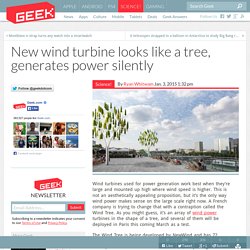

Wind Power. How it Works. Watch this: Watch 3 actual turbines in action!

SheerWind’s INVELOX Wind Delivery is simply a better way to harvest wind energy. Wind is captured at the top of the funnel shaped INVELOX system. The omnidirectional intake area allows wind collection from any directionWind is funneled through the systemWind is concentrated and further accelerated in the Venturi Effect* section of the INVELOX system.
*The Venturi effect is the phenomenon that occurs when a fluid that is flowing through a pipe is forced through a narrow section, resulting in a pressure decrease and a velocity increase.Wind is delivered to the turbine/generators to convert the accelerated wind to electrical power. This system of capturing, concentrating, accelerating, and harvesting wind power in a funnel is a patented system we call INVELOX™ (for INcreased VELocity). SheerWind’s mission is to provide sustainable, affordable, electrical energy to anyone, anywhere. inShare213. Third-World Wind Power: First Look. New wind turbine looks like a tree, generates power silently. Wind turbines used for power generation work best when they’re large and mounted up high where wind speed is higher.

This is not an aesthetically appealing proposition, but it’s the only way wind power makes sense on the large scale right now. A French company is trying to change that with a contraption called the Wind Tree. Environmental concerns with electricity generation. The environmental impact of electricity generation is significant because modern society uses large amounts of electrical power.

This power is normally generated at power plants that convert some other kind of energy into electrical power. Each system has advantages and disadvantages, but many of them pose environmental concerns. Water usage[edit] The amount of water usage is often of great concern for electricity generating systems as populations increase and droughts become a concern. Cost of electricity by source. Cost factors[edit] While calculating costs, several internal cost factors have to be considered.[2] (Note the use of "costs," which is not the actual selling price, since this can be affected by a variety of factors such as subsidies and taxes): Capital costs (including waste disposal and decommissioning costs for nuclear energy) - tend to be low for fossil fuel power stations; high for wind turbines, solar PV; very high for waste to energy, wave and tidal, solar thermal, and nuclear.Fuel costs - high for fossil fuel and biomass sources, low for nuclear, and zero for many renewables.Factors such as the costs of waste (and associated issues) and different insurance costs are not included in the following: Works power, own use or parasitic load - that is, the portion of generated power actually used to run the stations pumps and fans has to be allowed for.

Calculations[edit] It can be defined in a single formula as:[6] where System boundaries[edit] Discount rate[edit] . Blog » Clarity on the true cost of electricity. The question of electricity cost is tricky.

Most of us know oil prices go up and down – and are currently at record highs – which in turn affects the power price. And we know that not only to the costs of importing such fuels change constantly, they also – unlike renewables – produce carbon, which has to be paid for. The Sky Is the Limit for Wind Power. Wind turbines on land and offshore could readily provide more than four times the power that the world as a whole currently uses.

Throw in kites or robot aircraft generating electricity from sky-high winds and the world could physically extract roughly 100 times more power than presently employed—and the climatic consequences remain minimal. Two new computer-model analyses suggest there are few limits to the wind's potential. Although "there are physical limits to the amount of power that can be harvested from winds, these limits are well above total global energy demand," explains climate-modeler Kate Marvel of Lawrence Livermore National Laboratory, who led the analysis published September 9 in Nature Climate Change.
(Scientific American is part of Nature Publishing Group.) Current global demand is roughly 18 terawatts. Solar/Wind Power. Wind Power. Wind Energy. Wind. WWII veteran creates bird-friendly wind turbine. Military veteran Raymond Green created the Catching Wind Power prototype at an estimated cost of US$550 Image Gallery (17 images) World War II veteran Raymond Green, an 89 year old resident of Jackson, California, has created a working prototype of a "bladeless" wind turbine which is bird and bat-friendly, and very quiet in operation.

Though still in development at present, Green intends his design to be produced in various sizes, from smaller personal versions to much larger turbines which could be implemented in wind farms. View all The Compressed Air Enclosed Wind Turbine weighs 45 lb (20 kg) overall, while the turbine assembly itself measures 12 inches (30 cm) in diameter and the wind sock which surrounds it has a diameter of 31 inches (78 cm) at its widest point. In order to test the prototype, Green affixed it to the roof of his truck and drove around, producing enough power to light a bulb.
The short promo video below sheds some more light on the project. About the Author. Wind Power. Corporate Wind Power. DIY Windturbines.